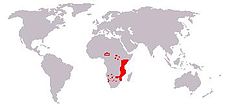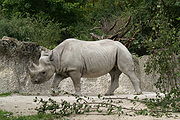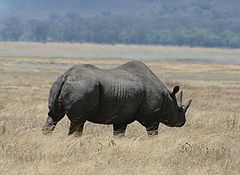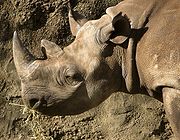
Black rhinoceros
Background to the schools Wikipedia
SOS Children has tried to make Wikipedia content more accessible by this schools selection. Child sponsorship helps children one by one http://www.sponsor-a-child.org.uk/.
| Black Rhinoceros | |
|---|---|
 |
|
| Conservation status | |
|
Critically Endangered ( IUCN 2.3) |
|
| Scientific classification | |
| Kingdom: | Animalia |
| Phylum: | Chordata |
| Class: | Mammalia |
| Order: | Perissodactyla |
| Family: | Rhinocerotidae |
| Genus: | Diceros |
| Species: | D. bicornis |
| Binomial name | |
| Diceros bicornis Linnaeus, 1758 |
|
| Subspecies | |
|
Diceros bicornis michaeli |
|
 |
|
| Black Rhinoceros range | |
The Black Rhinoceros (Diceros bicornis), also colloquially Black Rhino, is a mammal in the order Perissodactyla, native to the eastern and central areas of Africa including Kenya, Tanzania, Cameroon, South Africa, Namibia and Zimbabwe. Although the Rhino is referred to as black, it is actually more of a grey/brown/white colour in appearance.
The name of the species was chosen to distinguish it from the White Rhinoceros (Ceratotherium simum). This is misleading, as those two species are not really distinguishable by colour. The word white in the name "White Rhinoceros" derives from the Afrikaans word for "wide" rather than the colour white.
The World Conservation Union (IUCN) announced on 7 July 2006 that one of the four subspecies, the West African Black Rhinoceros (Diceros bicornis longipes), has been tentatively declared as extinct.
About 3600 Black Rhinoceros exist in the world.
Taxonomy and naming
There are four subspecies of the black rhinoceros:
- South-central (Diceros bicornis minor) which are the most numerous, and once ranged from central Tanzania south through Zambia, Zimbabwe and Mozambique to northern and eastern South Africa.
- South-western (Diceros bicornis bicornis) which are better adapted to the arid and semi-arid savannas of Namibia, southern Angola, western Botswana and western South Africa.
- East African (Diceros bicornis michaeli) which had a historic distribution from south Sudan, Ethiopia, Somalia down through Kenya into north-central Tanzania. Today, its range is limited primarily to Tanzania.
- West African (Diceros bicornis longipes) is an extinct subspecies. Historically, it once occurred across most of the west African savanna. Until recently, only a few individuals survived in northern Cameroon, but on July 8 2006 the World Conservation Union declared the subspecies to be tentatively extinct.
Description
An adult Black Rhinoceros stands 140–170 cm (57.9–63 inches) high at the shoulder and is 3.3-3.6 m (10.8–11.8 feet) in length. An adult weighs from 800 to 1364 kg (1,760 to 3,000 lb), but sometimes grows up to 1818 kg (4,000 lb), The females are smaller than the males. Two horns on the skull are made of keratin with the larger front horn typically 50 cm long, exceptionally up to 140 cm.
The longest known horn measured nearly 5 feet in length. Sometimes, a third smaller horn may develop. These horns are used for defense, intimidation, and digging up roots and breaking branches during feeding. Skin color depends more on local soil conditions and the rhinoceros' wallowing behavior than anything else, so many black rhinos are typically not truly black in colour. The Black Rhino is much smaller than the White Rhino, and has a long, pointed, and prehensile upper lip, which it uses to grasp leaves and twigs when feeding. White Rhinoceros have square lips used for eating grass. The Black Rhinoceros can also be recognized from the White Rhinoceros by its smaller skull and ears. Black Rhinoceros also do not have a distinguishing shoulder hump like the White Rhinoceros.
Their thick layered skin protects the rhino from thorns and sharp grasses. Their skin harbors many external parasites, such as crabs, which are eaten by oxpeckers and egrets that live with the rhino. They have terrible eyesight, relying more on hearing and smell. They have large ears that rotate much like satellite dishes to detect any sound and a large nose that has an excellent sense of smell to detect predators.
Distribution
For most of the 20th century the continental black rhino was the most numerous of all rhino species. Around 1900 there were probably several hundred thousand living in Africa. During the later half of the 20th century their number severely reduced from an estimated 70,000 in the late 1960s to only 10,000 to 15,000 in 1981. In the early 1990s the number dipped below 2500, and in 2004 it was reported that only 2,410 black rhinos remained. According to the International Rhino Foundation, the total African population has since then slightly recovered to 3,610 by 2003. According to a July 2006 report by the World Conservation Union, a recent survey of the West African Black Rhino, which once ranged across the savannahs of western Africa but had dropped to just 10, concluded the subspecies to be extinct. The northern white is soon to join the western black rhino on the extinction list as its last noted numbers were as few as 4. The only rhino that has recovered somewhat from the brink of extinction is the southern white whose numbers now are estimated around 14,500, up from fewer than 50 in the first decade of the 20th Century. The Black Rhinoceros has been pushed to the brink of extinction by illegal poaching for their horn and by loss of habitat. The horn is used in traditional Chinese medicine, and is said by herbalists to be able to revive comatose patients and cure fevers. The purported effectiveness of the use of rhino horn in treating any illness has not been confirmed by medical science. In June of 2007, the first-ever documented case of the medicinal sale of black rhino horn in the United States (confirmed by genetic testing of the confiscated horn) occurred at a Traditional Chinese Medicine supply store in Portland, Oregon's Chinatown. It is used in the Middle East to make ornately carved handles for ceremonial daggers called jambiyas. Demand for these exploded in the 1970s causing the Black Rhinoceros population to decline 96% between 1970 and 1992.
Behaviour and ecology
The Black Rhinoceros is a herbivorous browser that eats leafy plants, branches, shoots, thorny wood bushes and fruit. Their diet helps to reduce the amount of woody plants which results in more grasses growing for the benefit of other animals. Its been known to eat up to 220 different species of plant. It can live up to 5 days without water during drought. Black Rhinos live in primarily grasslands, savannahs and tropical bushland habitats.
They browse for food in the morning and evening. In the hottest part of the day they are most inactive spent resting, sleeping and wallowing in the mud. Wallowing is an essential part of all rhino species lives. It helps cool down their body temperature during the day and protects against parasites. If mud is not available they will resort to wallowing in dust. Drinking water is most commonly done towards the afterhours.
Solitary animals with the exception of coming together to mate, mothers and calfs will sometimes congregate in small groups for short periods of time. Males are not as sociable as females, although they will sometimes allow the presence of other rhinos. They are not very territorial and often intersect other rhino territories. Home ranges vary depending on season and the availability of food and water. Generally they have smaller home ranges and larger density in habitats that have plenty of food and water available, and vice versa if resources are not readily available. In the Serengeti home ranges are around 43 to 133 km², while in the Ngorongoro it is between 2.6 to 44 km². Black Rhinos have also been observed to have a certain area they tend to visit and rest frequently called "houses" which are usually on a high ground level.
The Black Rhino has a reputation for being extremely aggressive. They attack out of fear, confusion and panic. Due to their very poor eyesight they will charge if they sense a threat. They have even been observed to charge tree trunks and termite mounds. Black Rhinoceros are not very aggressive towards others of their species, usually only bluffing aggression. Males will fight sometimes by pushing head to head or horn jousting. They usually avoid other males when possible. Females are not aggressive towards each other. Despite their aggression, adult Black Rhinos have no natural predators, outside of an unverified incident of a huge nile crocodile taking down one.
Black Rhinoceros follow the same trails as elephants use to get from foraging areas to water holes. They also use smaller trails when they are browsing. They are very fast and can get up to speeds of 35 miles per hour (56kph) running on their toes.
Communication
Many forms of communication are exhibited by these animals. Due to their bad eyesight and solitary nature, scent marking is often used to identify other Black Rhinos. Urine spraying occurs on trees and bushes, around water holes and feeding areas. Females urine spray more often when receptive for breeding. Defecation occurs in the same spot used by many different rhinos found around feeding stations, watering tracks, and other areas. These are very important for identifying each other. Coming upon these spots, rhinos will smell to see who is in the area and add their own marking. Less commonly they will rub their head or horn against tree trunks to scent mark.
Different types of complex vocalizations have also been observed. Growls and trumpets may be used during a fight. A long snort indicates anger, while sneeze-like calls are used as an alarm to danger. Short snorts with pricked ears and wrinkled nostrils are a startled reaction to a newcomer. A high-pitched wonk has been described for when they are fearful. Even worse is a high-pitched scream observed in times of terror. "Mmwonk", a deep, resonant sound is a sign of contentment. Squeak, done with different tones and intonations can mean "I'm lost", "Where are you?", "I'm over here", and other emotions that are not yet understood. Breathing speeds can be used to communicate greetings, anxiety, and reassurance. A puffing snort is a common greeting when males and females encounter one another.
Body language is the least important of Black Rhinoceros communications. A bull will sometimes display an aggressive ritual towards a potential rival. They will smell, spray repeatedly, scrape, trample, and bash with their heads in bushes. They may also snort in an attack posture. When their tail is up, it may indicate one of several things: curiosity, alarm, or sexual receptivity. Erect ears also indicate curiosity, though flat ears express anger.
Reproduction

The adults are solitary in nature, coming together only for mating. Mating does not have a seasonal pattern but births tend to be towards the end of the rainy season in drier environments.
When in season the females will scrape their vaginas more vigorously with dung piles. Males following females that are in season will follow her; when she defecates he will scrape and spread the dung, making it more difficult for any other adult males to pick up her scent trail.
Courtship behaviors before mating include snorting and sparring with the horns among males. Another courtship behaviour is called bluff and bluster, where the rhino will snort and swing its head from side to side aggressively before running away repeatedly. Breeding pairs stay together for 2–3 days and sometimes even weeks. They mate several times a day over this time and copulation lasts for a half an hour.
The gestation period is 15 to 16 months. The single calf weighs about 35–50 kg at birth, and can follow its mother around after just three days. Weaning occurs at around 2 years of age for the offspring. The mother and calf stay together for 2–3 years until the next calf is born; female calves may stay longer, forming small groups. The young are occasionally taken by hyenas and lions. Sexual maturity is reached from 5–7 years old for females, and 7–8 years for males. The life expectancy in natural conditions (without poaching pressure) is from 35 – 50 years.


